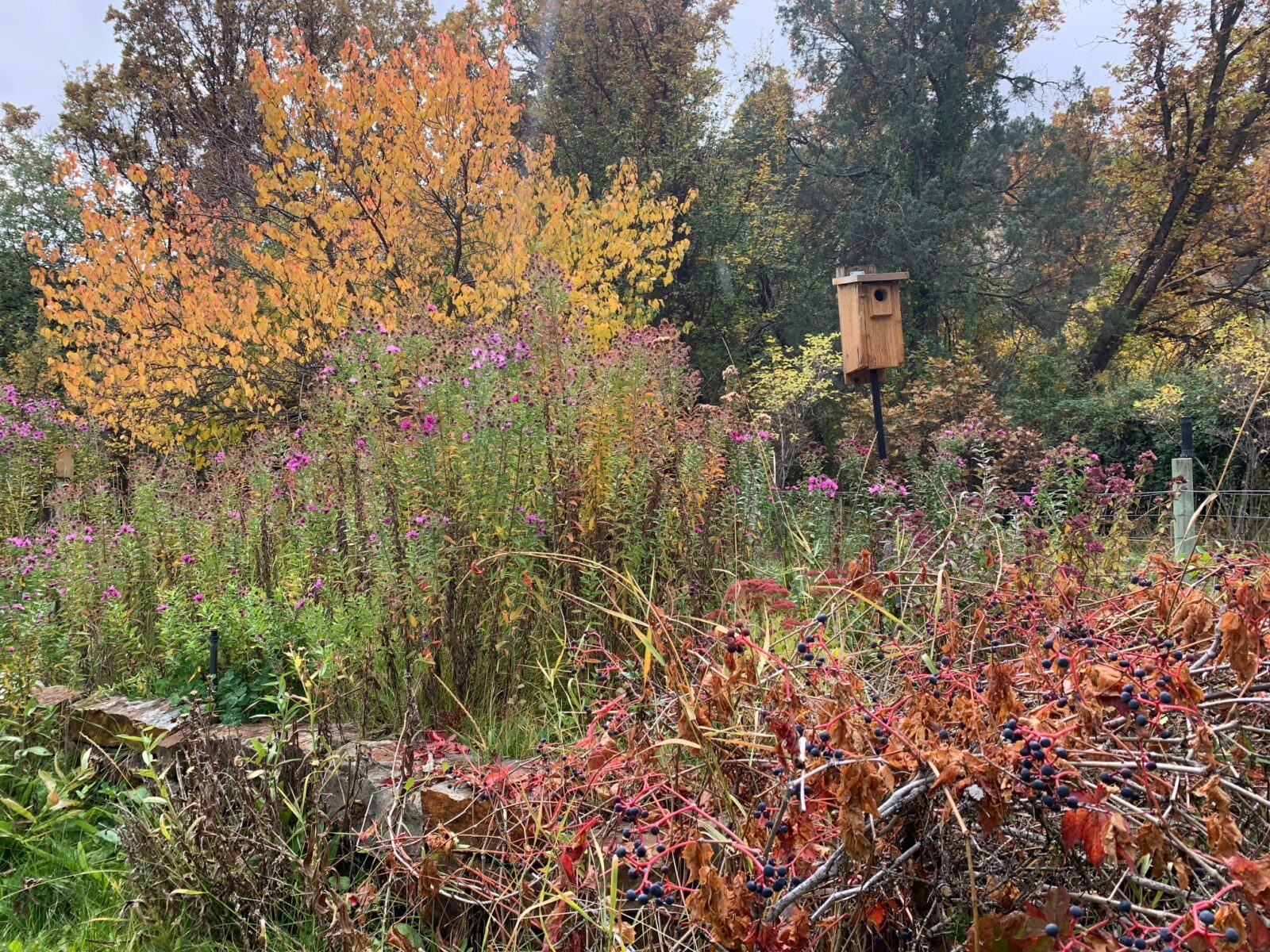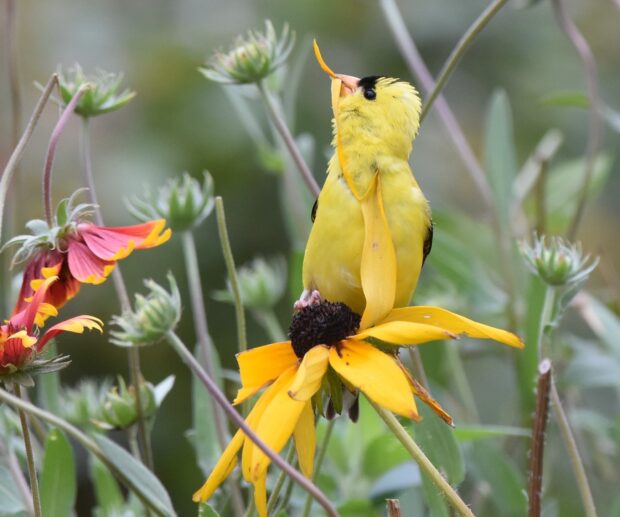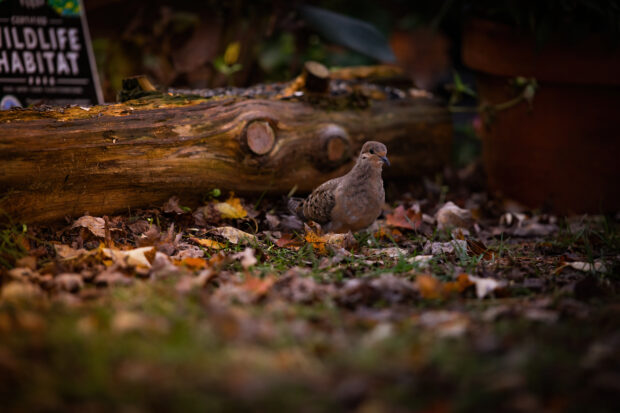We have much more to do and your continued support is needed now more than ever.
Five Simple Ways to Create Habitat this Fall

The idea of “gardening for wildlife” evokes images of beautiful, blossom-filled gardens teaming with colorful birds and butterflies. But did you know that fall is the best time to plant and that there are some specific things you can do in the autumn garden to support your local wildlife? Read on to discover five things that you should do in your garden this fall.
1. Plant Now – Fall is the Best Time
Don’t wait until spring to plant. As fall sets in with its cooler temperatures and lessening daylight, plants slow down and enter dormancy. In fall, deciduous trees and shrubs lose their leaves, evergreens slow down and perennial wildflowers and grasses die back. Their roots, however, remain active below the ground. That makes fall the best time to plant! Planting in the fall reduces the chance of transplant shock by allowing roots to get established and results in plants that are strong and vigorous when they come out of dormancy in spring.
You can also plant native wildflower seeds in the fall. The seeds of many native plant species need to go through a cold season in order to germinate, such as milkweed and red oaks. Sow seeds directly into your garden beds before the soil freezes to increase germination success next spring.
2. Provide Fall Food and Cover

Remember to include plants that offer food and cover for birds and other wildlife during the cooler months.
Berrying shrubs are a great choice. Bird species that don’t migrate away when summer ends depend on berries as a food source during the cold months, including northern cardinals, woodpeckers, bluebirds and mockingbirds. In addition to providing food, shrubs also provide great cover, both from predators and cold and wet weather. Evergreen species that hold onto their leaves provide extra cover benefit. Come spring, many bird species such as cardinals, hummingbirds and thrushes will build their nests in shrubs as well.
Also be sure to include native wildflowers that bloom in the fall, especially goldenrod and aster species. These not only provide a critical nectar source for migrating monarch butterflies, bees and other pollinators, their seeds are also an important food for many birds as fall progresses into winter.
Remember, the more you plant, the more food, cover and places to raise young you’ll provide, not just in fall but year-round. Plant densely and you’ll be more successful at attracting birds and other wildlife.
3. Don’t Go Crazy with Fall Cleanup
Conventional gardening advice dictates that you spend your fall weekends militantly raking up every leaf that falls and pruning and cutting back all your perennials to the ground. Not only does all this require a lot of work, it’s not really necessary! Limiting fall cleanup is actually an extremely beneficial thing to do for wildlife.
Here are some specific tips on how to minimize the yardwork in the fall and maximizing the benefit to wildlife:
Leave the Leaves
Believe it or not, fallen leaves are important habitat for many wildlife species, from songbirds and butterflies to salamanders and lizards—and even some bats! Incorporate the following to celebrate Leave the Leaves Month.
These practices reduce the amount of debris in landfills, while creating fertile new soil for your garden. A leaf layer several inches deep is a natural occurrence in any area where trees naturally grow. Many wildlife species live in or rely on the leaf layer to find food and other habitat, including salamanders, chipmunks, box turtles, toads, shrews, earthworms, and many insects species. Red-banded hairstreak butterflies lay their eggs on fallen oak leaves, which become the first food for their caterpillars.
- Rake leaves to garden beds or under trees to decompose to help amend soil and support water retention. This practice reduces the amount of debris in landfills, while creating fertile new soil for your garden.
- Create compost: Combine fallen leaves (“brown material”) with grass clippings and other “green material” and keep moist and well mixed. You’ll have nutrient-rich compost to add to your garden next spring.
- Make Leaf Mold: This is one of the easiest things to do with your dead leaves. Pile in a corner of your yard and let them decompose over time. It’s different than composting in that it is only leaves, no additional organic matter is added. Leaf mold improves soil structure and water retention.
Limit Deadheading and Trimming
Birds will eat seed heads of coneflowers and other seedy flowers. Seeds and berries that fall to the ground will attract other birds, like sparrows and buntings.
Grasses and perennials with hollow stalks can provide a place for pollinators and other insects to spend the winter. If you do trim spent perennials, leave 12-18 inches above ground.
Avoid Over Mulching
Repeated layers of hardwood mulch in both spring and fall seasons has the potential to impact the natural ecosystem between naturally falling leaves and organic debris and soil health. If mulch layers are too deep, they can impact both the wildlife looking for natural bed of protection and nutrients. Birds also forage for insects in these spaces and can be deterred by heavy mulch layers.
Use Branches, Trees and Logs
- Build a Wildlife Brush Shelter: Along with branches, sticks and stems, leaves can be used to make brush piles that shelter native wildlife.
- Dead trees provide vital habitat for more than 1,000 species of wildlife nationwide. They also count as cover and places for wildlife to raise young in the requirements for Certified Wildlife Habitat designation.
4. Certify Your Fall Habitat

Fall is a great time to assess the habitat value of your landscape or garden and plan out projects to make it even better for your local wildlife. How are you providing the four components of habitat—natural sources of food, water, cover and places to raise young—not just in fall but year-round? Could you adopt more wildlife-friendly ways of maintaining your landscape or garden? Use this Habitat Checklist to walk through your garden habitat space and assess all the ways you’re already meeting the requirements to have your garden spaces recognized as a Certified Wildlife Habitat by the National Wildlife Federation. It’s also a great guide for things you might not be doing yet. Many of the fall gardening practices we’ve suggested here will help you meet those requirements so you can proudly display the Certified Wildlife Habitat yard sign!
5. Have Fall Habitat Fun!

Your habitat garden is all about providing birds, butterflies and other wildlife neighbors with much-needed habitat, but it’s also the perfect place for you to enjoy nature every day. Don’t forget to get outside to enjoy watching all the wildlife you’re supporting.
The fall wildlife garden is also a great place to have to some fun with friends and family. There’s always so much going on, especially compared to the average yard that’s mostly just lawn. Check out National Wildlife Federation’s Green Hour for creative fall activities for all ages, like Fall in Love with Leaves, and Start a Fall Nature Notebook.
Another fun one is Making Leaf Art. Here’s how it works:
- Collect your favorite leaf shapes.
- Lay the leaf on a flat surface with the veins facing up.
- Lay a piece of paper on top of the leaf.
- Rub with the side of a crayon (or chalk or pencil) over the paper everywhere the leaf is.
- Watch the shape of the leaf appear!
We hope we’ve inspired you to continue your gardening activities through the fall to help support all of your wildlife neighbors beyond just the warm months!
Learn More!
Find out more about the benefits of fallen leaves in our on Leave the Leaves content series:























